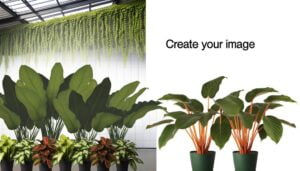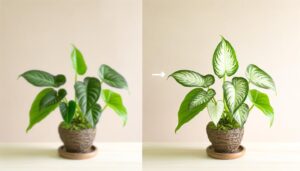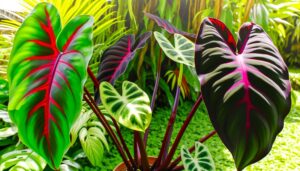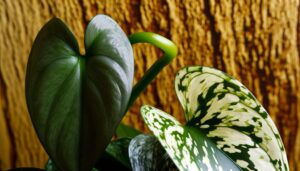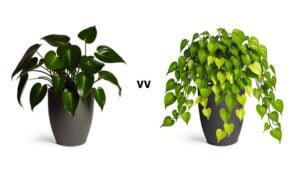Philodendron Plowmanii Vs Mamei: Differences and Care Tips!
Philodendron plowmanii and Philodendron mamei, both of Ecuadorian and Peruvian origin, differ markedly in several attributes. P.
plowmanii sports veined, undulating heart-shaped leaves, while P. mamei’s leaves are smooth and quilted with distinctive silver mottling.
P. plowmanii prefers lower elevations, thriving in consistently moist, diffused light environments, whereas P.
mamei adapts to higher altitudes with cooler temperatures and intermittent cloud cover. Growth habits diverge; P.
plowmanii spreads horizontally, and P. mamei exhibits a partially climbing tendency.
Detailed understanding of their specific environmental and care requirements can provide deeper insights.
Comparison of Philodendron Plowmanii and Philodendron Mamei
| Feature | Philodendron Plowmanii | Philodendron Mamei |
|---|---|---|
| Scientific Name | Philodendron plowmanii | Philodendron mamei |
| Common Name | Plowmanii Philodendron | Silver Cloud Philodendron |
| Leaf Shape | Heart-shaped | Heart-shaped |
| Leaf Texture | Smooth | Slightly ruffled, velvety |
| Leaf Color | Dark green with a silvery sheen | Dark green with silver patches |
| Growth Habit | Climbing or creeping | Creeping |
| Mature Size | Up to 3-5 feet indoors | Up to 2-4 feet indoors |
| Light Needs | Bright, indirect light | Bright, indirect light |
| Watering | Keep soil moist but not waterlogged | Keep soil moist but not waterlogged |
| Temperature | Prefers 65-80°F (18-27°C) | Prefers 65-80°F (18-27°C) |
| Humidity | High humidity (above 60%) | High humidity (above 60%) |
| Soil Type | Well-draining, rich potting mix | Well-draining, rich potting mix |
| Propagation | Stem cuttings | Stem cuttings |
| Toxicity | Toxic to pets and humans | Toxic to pets and humans |
| Special Care | Regular misting and occasional fertilizing | Regular misting and occasional fertilizing |
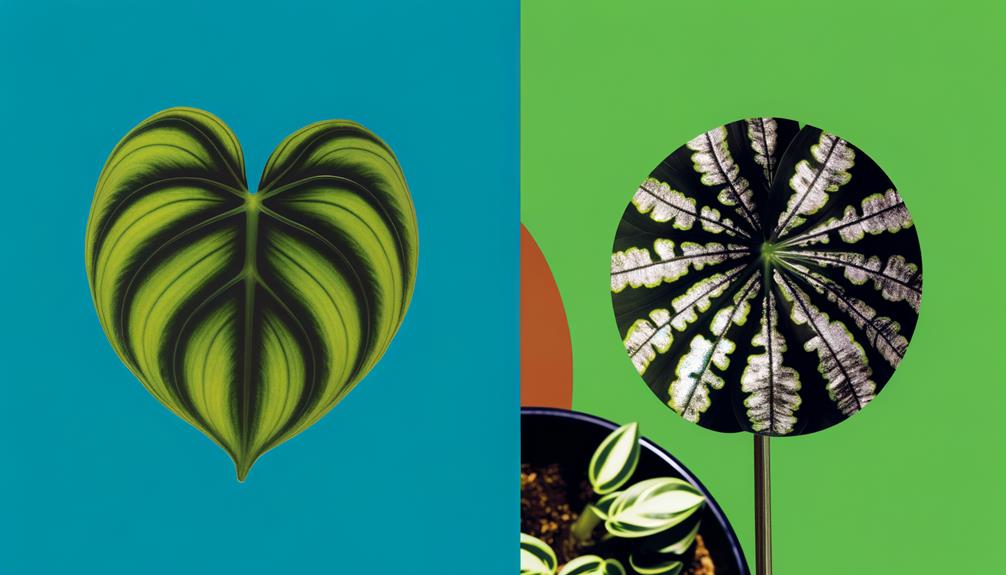
Origin and Natural Habitat
Philodendron plowmanii and Philodendron mamei, both belonging to the Araceae family, are native to the neotropical rainforests of South America, commonly found in the understory layers of Ecuador and Peru. These species thrive in humid, shaded environments with high organic matter content in the soil.
Plowmanii typically inhabits lower elevations, where it benefits from consistent moisture levels and diffused light. Conversely, P. mamei is often found at slightly higher altitudes, where it adapts to cooler temperatures and intermittent cloud cover.
Both species exhibit a hemiepiphytic growth habit; initially growing terrestrially and eventually climbing trees. This ecological strategy allows them to access higher light levels and efficiently utilize available resources within these biodiverse ecosystems.
Leaf Shape and Texture
The leaves of Philodendron plowmanii display a distinctive undulating texture with prominent veining, while those of Philodendron mamei are characterized by a smooth, quilted appearance and silver mottling.
Philodendron plowmanii’s leaves are heart-shaped, showing a pronounced corrugation and deep, intricate venation that gives a tactile, three-dimensional effect. In contrast, Philodendron mamei features broader, ovate leaves with a less pronounced veining pattern.
The smooth, quilted texture of P. mamei is accentuated by its unique silver mottling, which creates an iridescent effect under certain lighting conditions. This silver variegation is not just superficial but integrated into the leaf structure, providing both aesthetic appeal and functional adaptation.
These textural differences are essential for identifying and differentiating between these two species.
Growth Habit and Size
Philodendron plowmanii and Philodendron mamei exhibit distinct growth habits and mature dimensions, which are essential for understanding their care requirements.
Plowmanii typically demonstrates a creeping growth pattern, spreading horizontally. In contrast, Pmamei exhibits a partially climbing habit, often requiring support.
When it comes to their mature sizes, P. plowmanii can reach a width of up to 1 meter. On the other hand, P. mamei tends to have a more compact form, with leaves commonly growing to a length of around 60 centimeters.
Leaf Structure Comparison
Among the key differences between Philodendron plowmanii and Philodendron mamei, the leaf structure, particularly their growth habits and sizes, proves to be a significant distinguishing factor.
Philodendron plowmanii exhibits ovate to cordate leaves with prominent, undulating margins and a rough, almost quilted texture. These leaves can grow up to 60 cm in length, presenting a striking mottled pattern of green and silver.
In contrast, Philodendron mamei features heart-shaped leaves with a smoother texture and a distinct silver variegation along the veins. The leaves of P. mamei typically reach a slightly smaller size of around 45 cm in length.
Both species display a unique venation pattern, yet their overall leaf morphology remains a primary differentiator.
Climbing Vs. Crawling Growth
In addition to differences in leaf morphology, Philodendron plowmanii and Philodendron mamei exhibit distinct growth habits, with P. plowmanii primarily adopting a crawling growth pattern across the forest floor, while P. mamei exhibits a more versatile climbing or creeping growth habit.
Philodendron plowmanii, characterized by its prostrate growth, uses its rhizomes to spread horizontally, anchoring to the substrate. This adaptation allows it to maximize ground coverage in its native habitat.
Conversely, P. mamei shows flexibility in its growth form, capable of both terrestrial and epiphytic growth. This species employs aerial roots to ascend tree trunks or creep along surfaces, adapting to various environmental niches.
Such differences in growth habits highlight the ecological diversity within the Philodendron genus.
Mature Plant Dimensions
Typically, mature specimens of Philodendron plowmanii exhibit a prostrate growth habit, reaching dimensions of up to 3 feet in length, while maintaining a relatively low vertical profile. This species is characterized by its sprawling nature, with large, cordate leaves that can span up to 18 inches in width.
In contrast, Philodendron mamei grows in a more upright fashion, often achieving heights of up to 2 feet. The leaves of P. mamei are slightly smaller, generally around 12 inches in length, and exhibit a distinctive silver variegation.
Both species thrive in similar environmental conditions but exhibit markedly different growth habits and overall dimensions, making them distinct choices for botanical enthusiasts and horticulturists seeking specific aesthetic and spatial characteristics.
Light Requirements
Both Philodendron plowmanii and Philodendron mamei thrive under bright, indirect light, which mimics the dappled sunlight of their native tropical understories. Insufficient light can lead to etiolation, where the plants stretch and become leggy.
Conversely, direct sunlight may cause leaf burn, resulting in chlorosis or necrosis. Best light conditions promote healthy variegation and robust growth patterns.
| Light Intensity | P. plowmanii | P. mamei |
|---|---|---|
| Ideal Light Levels | 2000-3000 foot-candles | 2000-3000 foot-candles |
| Tolerance to Low Light | Moderate | Moderate |
| Reaction to Overexposure | Leaf burn, chlorosis | Leaf burn, chlorosis |
| Growth Under Low Light | Slower, leggy growth | Slower, leggy growth |
| Best Placement | East/West-facing windowsill | East/West-facing windowsill |
Ensuring appropriate light conditions is essential for maintaining the physiological and morphological health of these philodendrons.
Watering Needs
Watering needs for Philodendron plowmanii and Philodendron mamei exhibit distinct characteristics that must be carefully managed. Philodendron plowmanii generally requires more frequent watering due to its larger leaf surface area, which increases transpiration rates.
This species benefits from monitoring soil moisture levels to maintain a balance between adequate hydration and preventing waterlogged conditions.
On the other hand, Philodendron mamei prefers consistently moist soil but is more susceptible to root rot with excessive watering. Ensuring the soil remains consistently moist without becoming waterlogged is crucial for the optimal growth of both species.
Frequency of Watering
Philodendron plowmanii and Philodendron mamei exhibit distinct watering requirements due to their unique physiological adaptations and native habitats.
Plowmanii, hailing from the moist rainforests of South America, necessitates frequent watering to maintain its best growth conditions. Typically, watering every 7-10 days suffices, ensuring the soil remains consistently moist without becoming waterlogged.
Conversely, P. mamei, adapted to the cloud forests of Ecuador and Peru, requires less frequent watering. It thrives with watering intervals of approximately 10-14 days, as it is accustomed to environments with periodic moisture and high humidity.
Both species benefit from careful monitoring to avoid overwatering, which can lead to root rot and other deleterious effects. Regular observation of soil moisture is important for their well-being.
Soil Moisture Levels
Proper soil moisture levels are essential for the best growth of Philodendron plowmanii and Philodendron mamei, directly correlating with their respective watering requirements. Philodendron plowmanii thrives in substrates that retain moderate moisture yet permit adequate aeration, vital for root health.
Conversely, Philodendron mamei prefers consistently moist but well-drained soil, necessitating more frequent watering. Monitoring the moisture content guarantees optimal hydration and prevents common issues such as root rot or desiccation.
| Parameter | Philodendron plowmanii | Philodendron mamei |
|---|---|---|
| Preferred Soil Moisture | Moderately Moist | Consistently Moist |
| Soil Drainage | Well-draining, Aerated | Well-draining |
| Watering Frequency | Less Frequent | More Frequent |
| Root Health Indicator | Aerated Roots | Moist Roots |
| Common Issues | Root Rot, Overwatering | Root Desiccation, Underwatering |
Maintaining these parameters fosters robust growth and vibrant foliage.
Soil Preferences
Understanding the soil preferences of Philodendron plowmanii and Philodendron mamei is fundamental, as each species thrives in specific substrate compositions that maximize nutrient uptake and root aeration. Both species favor a well-draining, organic-rich soil mix but have nuanced requirements that cater to their unique growth habits.
- Philodendron plowmanii: Prefers a blend of peat, perlite, and orchid bark to guarantee adequate drainage and aeration.
- Philodendron mamei: Benefits from a mixture of coconut coir, compost, and sand, promoting moisture retention and root health.
- pH Level: Both species thrive in slightly acidic to neutral pH levels, ideally between 5.5 and 7.0.
- Organic Matter: High organic matter content is essential for nutrient supply and microbial activity, benefiting both species.
Detailed attention to these soil characteristics is vital for optimal growth.
Temperature Tolerance
Philodendron plowmanii and Philodendron mamei exhibit distinct temperature tolerance profiles, essential for best growth and health. Both species thrive within a recommended temperature range of 18-27°C, though their cold tolerance limits differ considerably, with P. plowmanii being more vulnerable to temperatures below 10°C.
Additionally, their response to heat stress varies, wherein P. mamei demonstrates a slightly higher resilience to temperatures surpassing 30°C.
Ideal Temperature Range
Both Philodendron plowmanii and Philodendron mamei thrive best in a temperature range of 18-27°C (65-80°F), showcasing their preference for warm, tropical climates. This temperature range supports ideal physiological functions, including photosynthesis, respiration, and transpiration.
Key factors for maintaining this range include:
- Consistent Monitoring: Regularly check ambient temperatures using dependable thermometers.
- Humidity Control: Maintain high humidity levels, typically above 60%, to replicate natural habitats.
- Avoidance of Drafts: Position plants away from windows and doors that may introduce cold air.
- Use of Grow Lights: Supplemental lighting can help sustain temperature, especially in cooler regions.
These measures facilitate strong growth and health, meeting the specific environmental needs of these Philodendron species.
Cold Tolerance Limits
While maintaining an ideal temperature range is vital for the growth of Philodendron plowmanii and Philodendron mamei, it is equally important to take into account their cold tolerance limits to prevent physiological stress and potential damage.
Both species exhibit reduced metabolic activity under lower temperatures, and prolonged exposure below 12°C (53.6°F) can lead to cellular damage and inhibited growth. Philodendron plowmanii, a native of tropical rainforest understories, exhibits slightly higher cold sensitivity compared to Philodendron mamei. These conditions can cause chlorosis, wilting, and necrosis of leaf tissues.
Hence, gardeners should make sure these plants are kept in environments that do not fall below these critical temperature thresholds to maintain peak health and vitality.
Heat Stress Response
In response to elevated temperatures, Philodendron plowmanii and Philodendron mamei exhibit distinct physiological adaptations, including increased transpiration rates and altered leaf morphology, to mitigate heat stress and maintain cellular homeostasis. These adaptations are essential for their survival in high-temperature environments.
Importantly, the following mechanisms are observed:
- Increased Stomatal Conductance: Improved stomatal opening facilitates greater water vapor loss, aiding in leaf cooling.
- Leaf Morphology Adjustments: Changes such as thinner leaves or increased leaf surface area improve heat dissipation.
- Heat Shock Protein (HSP) Expression: Elevated levels of HSPs protect cellular structures from thermal damage.
- Enhanced Root Water Uptake: Increased root efficiency guarantees sufficient water supply to counteract dehydration.
These strategies collectively enable both species to endure and thrive under thermal stress conditions.
Humidity Levels
Best moisture levels are crucial for the healthy growth of Philodendron plowmanii and Philodendron mamei, with both species thriving in environments maintaining 60-80% relative moisture.
Philodendron plowmanii, known for its striking heart-shaped, quilted leaves, benefits from high moisture to maintain leaf turgor and prevent desiccation. Similarly, Philodendron mamei, distinguished by its silver-patterned foliage, requires consistent moisture to prevent marginal leaf browning and promote peak cellular function.
Inadequate moisture can lead to stunted growth and increased vulnerability to pests like spider mites. Utilizing humidifiers or placing plants on pebble trays with water can effectively raise ambient moisture levels.
Accurate monitoring using hygrometers guarantees these tropical aroids receive the precise moisture necessary for robust development and aesthetic appeal.
Propagation Methods
Guaranteeing ideal humidity levels is just one aspect of successful cultivation; equally important is understanding the precise propagation methods for both *Philodendron plowmanii* and Philodendron mamei. Propagation primarily involves stem cuttings and air layering.
Here are the steps:
- Stem Cuttings: Select a healthy stem with at least two nodes. Use sterilized scissors to make a clean cut.
- Air Layering: For larger specimens, peel a small section of the stem to expose the cambium and wrap it with moist sphagnum moss.
- Rooting Hormone: Apply rooting hormone to cut ends to promote root development.
- Planting Medium: Place cuttings in a well-draining medium, maintaining consistent moisture and high humidity.
These methods secure robust growth and successful propagation.
Common Pests and Diseases
Both Philodendron plowmanii and Philodendron mamei are susceptible to a range of common pests and diseases, including spider mites (Tetranychidae), aphids (Aphidoidea), and bacterial leaf spot (Xanthomonas campestris).
Spider mites are minute arachnids that cause stippling and yellowing of leaves, often leading to desiccation. Aphids, small sap-sucking insects, can cause leaf curl and transmit viral diseases. Bacterial leaf spot manifests as water-soaked lesions that eventually turn brown and necrotic.
Effective management involves regular inspection, proper sanitation, and the application of miticides or insecticidal soaps for pest control. Bacterial infections necessitate the removal of affected tissues and the use of bactericides to mitigate spread. Ensuring ideal growing conditions can also reduce susceptibility.
Philodendron Plowmanii X Mamei
The Philodendron Plowmanii x Mamei is a hybrid that combines the distinct characteristics of both parent plants, Philodendron Plowmanii and Philodendron Mamei, resulting in a unique and visually striking plant.
Here’s a closer look at this intriguing hybrid:
Leaf Characteristics
- Color and Pattern: The leaves usually exhibit a blend of the silvery patches characteristic of Philodendron Mamei and the broader, more robust shape of Philodendron Plowmanii. This hybrid often features the intricate silver patterning seen in Mamei, making the leaves visually captivating.
- Shape and Texture: The leaves tend to be large and heart-shaped with a slightly wavy margin, resembling Plowmanii’s form but inheriting the thick, leathery texture from Mamei.
Growth Habit
Like both parent plants, this hybrid tends to exhibit a creeping or crawling growth pattern, spreading horizontally and producing new leaves from rhizomes that run along the surface of the soil. It’s robust and can become quite expansive with time, making it suitable for larger indoor spaces or as a striking ground cover in tropical garden settings (where climate permits).
Care Requirements
- Light: Prefers bright, indirect light. Direct sunlight can damage the leaves, but too little light will reduce the vibrancy of the leaf color and patterns.
- Soil: Needs well-draining, fertile soil. A mix containing peat, perlite, and some organic matter works well to support its growth.
- Water: It’s important to water regularly, allowing the top inch of soil to dry out between watering. Ensure good drainage to prevent root rot.
- Humidity: High humidity levels are beneficial, mimicking the plant’s native tropical environment. Regular misting, a pebble tray, or a humidifier can help meet its humidity needs.
Overall Appeal
The Philodendron Plowmanii x Mamei is highly prized among plant collectors for its ornamental leaves and relatively easy care. It’s a great choice for enthusiasts looking to add a touch of the tropical and exotic to their indoor or sheltered outdoor plant collections.
The hybrid’s robust nature and beautiful foliage make it an appealing addition for both novice and experienced plant lovers.
Conclusion
To sum up, Philodendron plowmanii and Philodendron mamei, each with their unique morphological characteristics and environmental inclinations, present a vibrant depiction of botanical diversity.
The former’s heart-shaped, quilt-like leaves stand out distinctly from the latter’s metallic-silver, undulating foliage, showcasing nature’s complex craftsmanship.
Both species require particular light, water, and humidity levels suited to their original environments.
Proficiency in meeting these needs is crucial for effective cultivation, guaranteeing the flourishing of these botanical wonders, free from pests and diseases.

